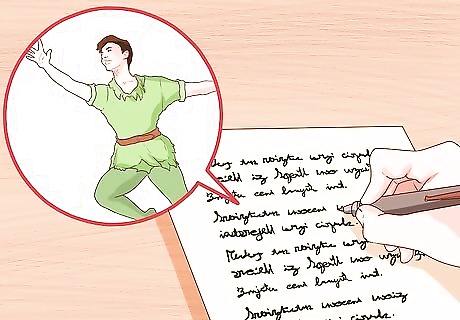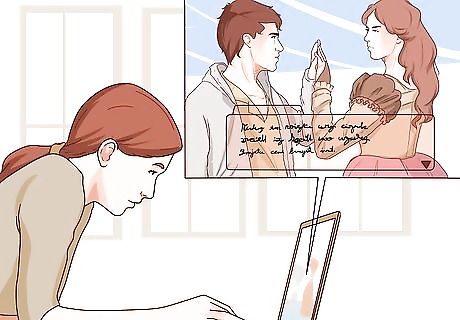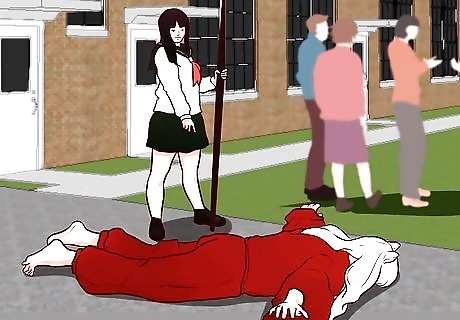
views
Getting into Characters for Plays and Re-Enactment

Write an essay about your character. Ask yourself some questions about your character, and try to answer them. It may help you understand your character better. This is a good idea not only for characters in a play, but also for cosplays, Renaissance Faire (and other re-enactment) characters, and original larp characters. Here are some questions you should ask yourself: What does your character look like? Are there any unique features, such as a limp or hump? How does your character speak? Do they have a lisp or an accent? What is your character's station in life? Are they part of the upper class, such as a king? Or are they from the lower class, such as a town drunk? What does your character want? Do they get that? How does your character resolve problems? Do they get frustrated? Do they expect others to solve it for them? What do others expect from your character? How does your character feel about those expectations? Do they meet them, surpass them, or fail them? How do other characters feel about your character? Is your character well liked, or disliked?

Read the whole play. This includes the parts that your character doesn't appear in. If you only read the parts with your character, you might miss important events that they might be aware of. These events might affect how they behave.

Read essays about the character, especially if it is a character from a play. Don't just go for any essays, however. Go for scholarly and peer-reviewed essays. Many of these essays will go in depth on the character, and analyze their thoughts, behavior, and role in the play. For example, Shylock from The Merchant of Venice can be a villain or a victim. The essays you read might help you decide how to depict him: villain or victim. This also applies to historical roles for Renaissance Fairs and other historical reenactments.

Watch other interpretations of the character with care. Your director may want you to interpret your character differently from how they are depicted in other versions of the play (especially filmed versions).

Read the book, if the play is based off of one. Some plays are based off of books, but they don't always tell you everything about a certain character. The book, however, might give you that information. It might show you how the character behaves "off-stage." You can use this information when acting as your character. Examples of plays (and musicals) based off of books include: Dracula The Phantom of the Opera Beauty and the Beast and The Lion King are not based off of books, but movies. In this case, you might want to watch the movie.

Read about the character's world. Most plays will take place in a past time period. You can make your character more believable by learning about that time period. The one exception to this, of course, is if the director wants to do a modern interpretation of a play. An example would be setting Romeo and Juliette during the 1940s, with one family being Jewish and the other being German, instead of during the Renaissance.
Getting into Character for Cosplay

Watch their episodes, if possible. Study how the character talks, acts, and moves. Note how they behave towards other characters. Some people act differently towards different people.

Read the books/manga/comics. Keep in mind that the print version of the character can be different from the film version. This may include how the character looks and acts. The character's backstory may also change. Some people find it easier to remember a character's quotes if they are written, rather than spoken.

Play the games, if possible. Some characters also appear in video games. These games can tell you more about the character. Some games even expand the character's backstory. Keep in mind, that not every character will appear in a video game—and if they do, it may not always be a large part. Make sure that you play licensed gamed and not fan-created games. Fan-created games do not always portray the characters accurately. Instead, they often cater towards certain parts of the fandom.

Study the character and learn the character's backstory. The backstory can explain why a character acts the way they do. For example, Severus Snape from Harry Potter, is often mean, especially to Harry Potter. His backstory, however, reveals that he was bullied by Harry's father. The backstory can also give you ideas for interacting with other cosplayers.

Take note of how the character talks. You will also want to note their facial expressions. These tiny details can help bring your cosplay to life and make it more believable. Note speech patterns. Does the character have a casual way or talking, or a more old-fashioned, archaic way? For example, Thor from the "Avengers" often uses old, archaic terms such as "thou." Note repeated words or phrases. For example, Reno from "Final Fantasy VII" often ends his sentences with "yo." Note the way a character talks. Does your character talk fast in a pitchy voice? Or does he have a slower, halting way of talking? Severus Snape is known for having very long... pauses... when he speaks.

Take note of the character's manners and actions. Study the way the character walks and stands. This can help make your cosplay more believable. After all, a Gaston (from "Beauty and the Beast") who slouches all the time will not be very convincing. Gaston would stand tall and proud! Is the character known for reacting a specific way to certain words and phrases? For example, Edward Elric from "Fullmetal Alchemist" gets very, very upset whenever someone implies that he is short. Does the character have a specific walk? Captain Jack Sparrow from "Pirates of the Caribbean" has a very distinctive, swaying walk, often accompanied by a confused look and expressive hand gestures.

Don't be afraid to interact with other cosplayers. Sometimes, it is easier to get into character when you have a friend (or another friendly cosplayer) to play along with you. Keep in mind, however, that not every cosplayer will want to play along. If they don't react to you, move on. Do not force them to play along with you, or they may report you to con-ops for harassment. Envy from "Fullmetal Alchemist" would never skip a chance to call Edward Elric "short." If you are cosplaying Envy and you spot and Edward, try yelling out: "Hey, Fullmetal Shrimp!" and watch the hilarity ensue. The Marauders from Harry Potter were known for tormenting Severus Snape. If you are cosplaying a young James or Sirius, and you come across a young Severus Snape, try calling him Snivellous—but don't be alarmed if he responds with a hex! Kagome from "Inuyasha" disciplines the dog demon by yelling "SIT," which forces him to sit down. If you see an Inuyasha misbehaving or being rude, be sure to discipline him by saying: "Inyuasha! Sit!"
















Comments
0 comment